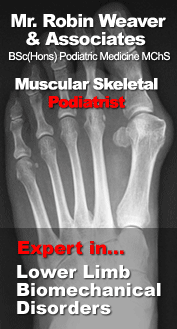Jump to...
The examples below are not exhaustive, they simply illustrate
some common examples of orthotic types.
 |
 This is a standard polypropylene orthotic with a vinyl
top cover and a rearfoot post made of EVA (ethyl vinyl
acetate). It is metatarsal length, extending to just behind
the ball of the foot.
This is a standard polypropylene orthotic with a vinyl
top cover and a rearfoot post made of EVA (ethyl vinyl
acetate). It is metatarsal length, extending to just behind
the ball of the foot. |
 |
 This is a similar type orthotic with a top-cover of soft
shock-absorbing material extending to the ends of the
toes. It can completely replace any insole that comes
with the shoe.
This is a similar type orthotic with a top-cover of soft
shock-absorbing material extending to the ends of the
toes. It can completely replace any insole that comes
with the shoe. |
 |
 This is an orthotic cut for dress shoes with low heel
height. It is similar to the standard orthotic above,
but is cut more narrow with a lower bulk rearfoot post.
This is an orthotic cut for dress shoes with low heel
height. It is similar to the standard orthotic above,
but is cut more narrow with a lower bulk rearfoot post. |
 |
 This orthotic is for high heeled dress shoes. Women who
must wear this type of shoe, can do so with greater comfort.
This orthotic is for high heeled dress shoes. Women who
must wear this type of shoe, can do so with greater comfort. |
 |
 Some orthotics incorporate a top cover of nylon covered
neoprene for extra cushioning and a reduction in shear
forces within the shoe. These forces cab case blisters
and calluses. This is a sports orthotic. It is often cut
wider and made of more flexible plastics or carbon-fiber
composite material. Orthotics are sometimes customized
for particular sports such as court sports, running, basketball,
skiing, etc.
Some orthotics incorporate a top cover of nylon covered
neoprene for extra cushioning and a reduction in shear
forces within the shoe. These forces cab case blisters
and calluses. This is a sports orthotic. It is often cut
wider and made of more flexible plastics or carbon-fiber
composite material. Orthotics are sometimes customized
for particular sports such as court sports, running, basketball,
skiing, etc.
|
 |
 This is a gait plate. It is made for young children with
structural foot abnormalities.
This is a gait plate. It is made for young children with
structural foot abnormalities. |
 |
 This illustrates an orthotic with a rearfoot post, a forefoot
post, and a full-length top cover. The plate is made of
a copolymer which provides increased flexibility and shock
absorption. This orthotic is for a patient with a high-arched
foot.
This illustrates an orthotic with a rearfoot post, a forefoot
post, and a full-length top cover. The plate is made of
a copolymer which provides increased flexibility and shock
absorption. This orthotic is for a patient with a high-arched
foot. |
 |
 This is a orthotic insert. It is soft and flexible, and
extends full-length. It is appropriate for certain high-arched
feet, and elderly patients or those with advanced arthritis.
This is a orthotic insert. It is soft and flexible, and
extends full-length. It is appropriate for certain high-arched
feet, and elderly patients or those with advanced arthritis. |
 |
 This orthotic incorporates three layers of different materials
which together help to cushion and accommodate for painful
areas and calluses. It is for the high-risk or deformed
foot. We often prescribe this for diabetics.
This orthotic incorporates three layers of different materials
which together help to cushion and accommodate for painful
areas and calluses. It is for the high-risk or deformed
foot. We often prescribe this for diabetics. |
Prefabricated foot orthotics are useful for treating a range of minor foot and leg ailments. They are not however designed to replace bespoke prescription orthotics. Prefabricated foot orthotics supplied from this website have been manufactured with computer assisted design and computer aided manufacture. Unlike prescription orthotics prefabricated orthotics are not made to an individual prescription or by using models of feet known as casts. Prefabricated devices are fabricated using computer generated data. The data is based on biometric information gained from the analysis of tens of thousands of actual feet with pronation problems.
In the same way you would not attempt to treat a complex eye disorder by using reading glasses such as those sold in supermarkets you should not attempt to self treat complex biomechanical issues with off the shelf orthotics. However they are useful for a wide range of conditions particularly if they have not become chronic in nature. Unlike other prefabricated orthotics the Prostep range of prefabricated devices available from this website can be customized by Podiatrists to tailor them to your specific requirements. This is possible as the orthotics have a recess in both the forefoot and rear foot areas which accept wedges known as posts. The Prostep orthotics are supplied with a variety of rear and forefoot post from 3 or 5 degrees. These posts are not essential and should only be added after you have tried the orthotics in their neutral position for several weeks and ideally should be added after seeking professional advice.
A range of Prefabricated Orthotics are availabe to purchase from this site. Please visit our Shop page.

